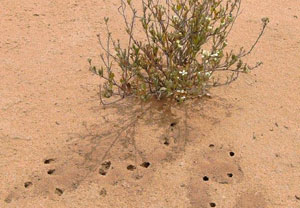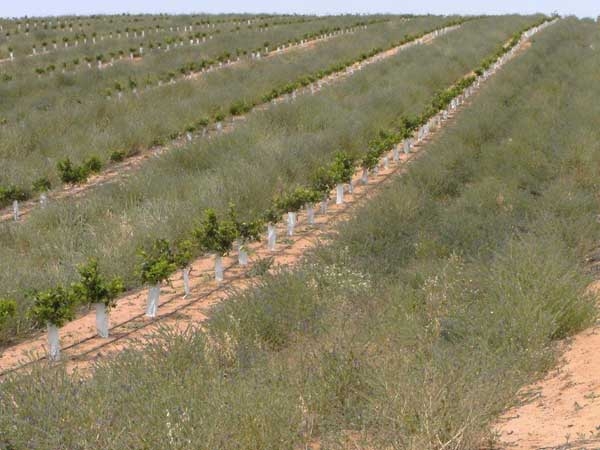Establishing a new citrus orchard on the windblown sand hills in the southern Riverina of New South Wales is a challenge.
| Location | Mowbray Citrus, Berrigan NSW. |
| Problem | Wind, and blown sand damaging newly planted trees. |
| Solution | Integrated Crop Management (ICM) using local ‘weeds’ as windbreaks. |
It’s a test of the persistence and endurance of the trees, and the resourcefulness of growers against the challenges of the environment.
The sand hills in the area are quite high with deep gullies. The sands have extremely low organic matter, low water-holding capacity, and poor nutrient retention.
The sands are a good medium to support the plant, but offer very little else.
Soil reclamation
The sand hills grew fresh market potatoes for many years, so soil reclamation was the first step in establishment.
These sands were maintained at low pH for disease control, and the long-term use of urea fertiliser with no other cropping, resulted in a strong acidic soil profile.
Lime and gypsum were applied down the tree lines; double drip lines and a state-of-the-art fertigation system were installed. The first trees were planted in March 2011.
The sand hills are very prone to wind—hence sand blasting any crops—especially around the spring and autumn equinox.
To overcome the winds and damage from windblown sand, a range of crops such as millet and sorghum were grown to act as wind breaks.
However, as we all know, it rarely rains at the right time, so these crops never had the rains early in the season for emergence of the crops and they didn’t establish to develop as windbreaks.
On the exposed tops of the sand hills, the crops died out completely and didn’t even provide any ground cover.
Clever use of the environment
The alternative (shown in the images) illustrates the clever use of the environment.
While Paterson’s curse, also known as salvation Jane (Echium plantagineum), may not be seen as natural, it is an established weed and part of the local landscape.
By using a ‘weed’ that tolerates the conditions and grows without irrigation in a most difficult climate (trees are drip irrigated so no irrigation water reaches the sward between the rows), the winds pass over the top of the citrus trees and are protected from the blown sand.
This system will give protection to the trees for two to three years—until they are well over the height of the Paterson’s curse.
Weed control & benefits
The problems that the Paterson’s curse produces, have been managed with a covered treeline sprayer for treeline weed control.
The Paterson’s curse also provides an insectary for their biological controls that have been released. Seven insects that attack all stages of Paterson’s curse have been released in Australia.
There are disadvantages to having such an important weed, however, in this situation the advantages are much greater than any disadvantage.
Spectacular biological activity
While taking pictures of the wind break created by the Paterson’s curse, I noted some spectacular biological activity.
There were sporadic armyworm caterpillars in the young citrus trees giving some—but not significant—leaf damage.
In the sward of Paterson’s curse, there were huge numbers of armyworm caterpillars and platoons of sand wasps controlling them.
 Sand wasps
Sand wasps
The female sand wasp stings and paralyses her prey. She then carries the caterpillar to the nest she has dug in the sand and places the immobilised caterpillar inside the nest where an egg is then laid.
The developing wasp larva feeds on the paralysed caterpillar prey—a great example of IPM in practise.
In the image above, sand wasp nests can be seen dug into the sand along the treeline and around the weeds.
There were a number of different wasps, but the sand wasp was the most common.
Click on links below or try Google images and YouTube for more information.
www.brisbaneinsects.com/brisbane_insects/Predators.htm
www.australianmuseum.net.au/search?keyword=wasps
Family Sphecidae - Mud-Daubers, Thread-waisted Wasps and...
www.brisbaneinsects.com/brisbane_apoidwasps/SPHECIDAE.htm
http://anic.ento.csiro.au/insectfamilies
For more information and images, see Dec 2012 Tree Fruit






















